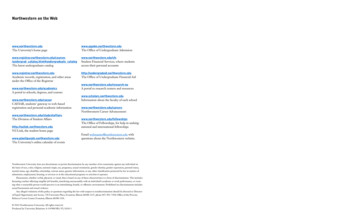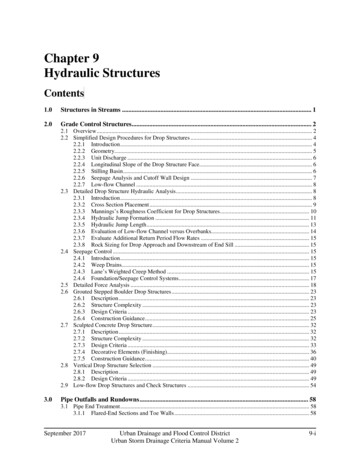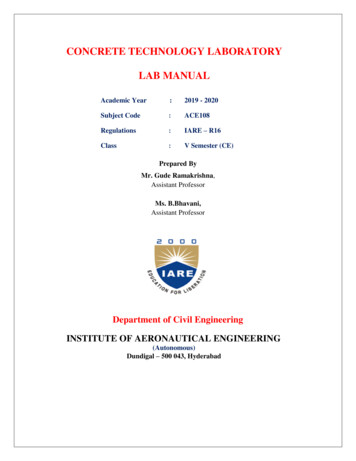
Transcription
461COMPUTER MODELLINGOFCONCRETE STRUCTURESCreep and Thermal Effects in Concrete Structures:A Conspectus of Some New DevelopmentsBy ZDENEKEdited byP.BAZANT 1H. MANGTechnical University, Vienna, AustriaN. BICANICUniversity of Wales, Swansea, U K.R. DE BORSTDelft University of Technology, NetherlandsABSTRACT. The lecture reviews some recent developments in the theory ofcreep and thermal effects in concrete structures. T e formulation of the solidification theory for the effect of aging due to cement hydration on concrete creepis summarized, a new operator-type formulation for the theory is given and a newgeneral statement of the computational algorithm is presented. Also, a reformulation of the solidification theory on the basis of a continuous retardation spectrumis outlined. The dichotomy of the two-fold influence of temperature, consisting inthe acceleration of creep rate and the acceleration of hardening due to hydration,is discussed and its formulation given. Attention is then focused on the interaction of creep with fracture mechanics, and a time-dependent generalization of thecohesive (fictitious) crack model is described, along with the compliance methodof structural analysis for time-dependent cohesive fracture. Finally, some recentnovel experiments that separate the mechanisms of the creep increase due to dryingare reviewed and the effects of drying on a structure such as a box girder bridgesegment is explored. The lecture concludes with a brief discussion of currentlyimportant research directions.1Proceedings of EURO-C 1994 International Conferenceheld in Innsbruck, Austria22nd-25th March, 1994IntroductionThe long-time creep strains of concrete under service stresses are typically2 to-6 times larger than the short-time elastic strains, and even short-timedeformations of about 10 minute duration comprise 25 to 50% of creep. Thus,consideration of creep is obviously important for a realistic analysis of concretestructures.Major advances have been made in the understanding of creep during thelast two decades, principally driven by the needs of design of nuclear powerlWalter P. Murphy Professor of Civil Engineering, Northwestern University, Evanston, IL60208, USA
463462plants. Although this subject has recently become politically unpopular, manynuclear plants exist around the world. Their state of stress and deformation ischanging over the years. Insuring their continued safety requires paying attention to creep. The main need for creep analysis now arises from the ubiquitousproblems with concrete infrastructure of most nations. Misunderstanding andmispredictions of creep, thermal effects and moisture effects is no doubt astrong contributing factor in these problems. Equally important is creep forthe analysis, evaluations and long-time fracture predictions of dams-a technology that has so far caused many more fatalities than nuclear power.The theory of creep and of the related effects of moisture and temperatureis greatly complicated by several phenomena: (1) the aging, caused by longtime chemical changes; (2) long-time cracking and fracture; (3) complex andmultifaceted thermal effects, which affect hardening and creep rate in mutuallycompeting ways; (4) coupling to the diffusion problems of moisture and heat;and (5) strong stochastic variability engendered by high sensitivity to environmental conditions and to the variability of concrete mixes and ingredients. Nowonder, therefore, that the theory of creep remains one of the most importantand challenging aspects of concrete structural design.The present lecture attempts to give a conspectus of some new developments, focusing chiefly on those attained at the writer's home institution (withwhich he is most intimate). One recent development in the constitutive modeling of creep is the solidification theory, whose latest improvements will bediscussed first. Subsequently, attention will be focused on the interaction ofcreep with the damage due to cracking and with the growth of fracture. Furthermore, some recent developments in the modeling of thermal effects will behighlighted and an improved analysis of the drying creep mechanism will bebriefly mentioned, along with some finite element applications. The lecturewill conclude with comments on promising research directions.cate hydrates). From a more precise viewpoint, the hardened cement gel mightfurther be broken into certain sub constituents because its structure also undergoes changes. There is a certain process of polymerization representing agradual increase of the internal binding of the hardened cement gel. Such aprocess may explain why the creep decreases with the age at loading even longafter the volume growth of the hydration products has ceased.To sum up, consideration of the change of volume of some nonaging constituent is the basic requirement for a sound thermodynamic description of theeffect of aging on the creep of concrete. Such a description was introduced in[2], in which the model visualized in Fig. 1 was proposed, based on a gen ralconcept promulgated in [3]. It was assumed that a non aging constituent, suchas the non-polymerized hardened cement gel, is growing by additions of layerscoupled in parallel, as shown in Fig. 1. Now the basic fact to take into accountis that at the moment a layer of the material solidifies and gets attached tothe existing solid, it is stress free. This simple fact dictates a certain form ofthe compliance function, which is used in the solidification theory, and alsoa certain special form of the equations for the aging springs in the rheologicmodel (some of the previous formulations in the literature violated this form,which must be regarded as physically unaccep tion Theory['VISCOUS(flow)The aging, which complicates the formulation of linear viscoelasticity of concrete, cannot be regarded as an actual change of the mechanical propertiesof the matter constituting conc ete. Chemical substances generally have fixedproperties in time. The change of mechanical properties in time must be regarded as a change in the concentrations of various substances in concrete.This is the same as in chemical thermodynamics where the properties of a system change' not because of a change of the properties of its constituents butbecause of a change in the concentrations of time-invariable constituents. Todescribe a system of time-variable properties in the spirit of chemical thermodynamics, the system must be broken down to its time-invariant constituentsand the changes in their quantities must be considered as the basic variables.Without this approach, the thermodynamic theory for concrete viscoelasticitycannot be property formulated.In the case of concrete, the non-aging constituent is the hardened cementgel (roughly the tobermorite gel, consisting mainly of tri- and bi-calcium sili-[0t'-,. thermal crackIngFigure 1: Visualization of solidification theory in conjunction with the Kelvin chain.model; after [2-3].According to the solidification theory [2], the constitutive law for linearaging creep of concrete is written as follows: eT( t)Eol --in whichitl(t) v t) i'(t), l l.J.tI(1)(2)
465,(t) i (t(3)- t')do-(t') Here (T, Euniaxial stress and strain in concrete, ,effective strain in thesolidifying constituent on the microscale, EVviscoelastic strain, Ef viscousstrain (or flow), 7](t)associated viscosity which depends on the age t ofcORcrete, vet) volume (or volume concentration) of the solidified constituentat age t, Eo asymptotic elastic modulus representing the material stiffnessfor extremely fast deformations (extrapolated to zero load duration), and (t t') nonaging linear viscoelastic micro-compliance function for the solidifyingintegration variable). Note that the solidification theoryconstituent (t'prohibits replacing Eq. (2) by EV(t) ,(t)/v(t), which would violate thesecond law of thermodynamics (however, some formulations which imply sucha relation can be found in the literature). The aging is described by twofunctions, vet) and 7](t). Note that one of these functions would not suffice,except as an approximation when long-time creep of concrete loaded at a youngage is not of interest. Note also that the compliance function should includeeven the very rapid short-time creep that causes the difference between thedynamic elastic modulus and the static elastic modulus; otherwise the elasticmodulus E would have to be considered as age-dependent and the formulationwould actually become more complex.Based on the essential properties of creep curves observed in experiment,the following expressions were proposed and verified by test data [2]: (t - t')e (t - to)/ '0,1( . )-m vet) o q21n(1 en),17](t)withq4 t'0 '0 1 day(4)(5)in which to is the time of applying a constant unit uniaxial stress; m, nand '0 are constants that can be fixed once for all, for all the concretes; m0.5,n0.1; and q2,q4 are empirical parameters to be identified be fitting ofdata on each particular concrete or predicted from some approximate creepprediction model based on the composition and the strength of concrete. Themacroscopic uniaxial compliance function which ensues from Eqs. (4) and (5)is then obtained as t(6)J(t,t o) qt l i(T,to)dTt oThe compliance rate is.n (q2t-m q3)J(t, to) (t to) (t - to)t-nq4 t(7)in which ql and q3 are additional empirical constants to be identified fromtest data for each particular concrete or predicted from the composition andstrength. An important advantage of this formulation is that the parametersQl, Q4 are all involved linearly, which means that they can be obtained froJYItest data by linear regression (which is always convergent, unlike nonlinearregression) .The compliance function is given according to Eq. (6) by an integral which,for the expression in (7), is a binomial integral and is not integrable in a closedform. This is no problem for computer programs solving the creep problem intime steps, because only the compliance rate j, is needed for that purpose. Forsimple code-type calculations, the values of J can be obtained by numericalintegration, or can be calculated .from a simple explicit approximate formulagiven in [2]. Tables and graphs for the values of J have also been prepared [2].Aside from the physical and thermodynamic justification, the solidificationtheory has also two important practical advantages: First, it guarantees avoidance of the so-called divergence of the creep curves for different ages at loading,which also avoids problems with nonmonotonic creep recovery and nonmonotonic relaxation recovery. Second, in lends itself to a much simpler rate-typeformulation suitable for finite element programs, which we review next.3Operator-Algorithmic Method with Internal VariablesThe integral type description of linear viscoelastic behavior is a strictly phenomenological concept lacking any physical basis. It implies the notion ofmemory, yet the material has no memory per se. The memory property arisesindirectly. It is embedded in the current values of many variables characterizingthe state of the microstructure. These variables are approximately reflected incontinuum theories of materials by means of the so-called internal variables (orhidden variables). Their current values take into account the previous stressor strain history of the material.The internal variables can be regarded, in linear viscoelasticity, as the deformations or stresses in the elements of spring-dashpot rheological models.Although there are infinitely many possible geometric configurations of suchmodels, it was proven by Roscoe [1], for nonaging viscoelasticity, that the mostgeneral possible viscoelastic behavior can be approximated with any degreeof accuracy by either the Kelvin chain model or the Maxwell chain model.This makes it unnecessary to consider any more complicated models. Eachunit of such a model is described by a first-order differential equation in time,and thus the integral-type creep law is converted to a system of first-orderdifferential equations in time. These differential equations, unlike the integralequation, can be correlated to various physical concepts for the processes inthe microstructure, for example the activation energy controlled rate processfor the breakages of bonds that are the source of creep.The rate-type form of the creep law can be obtained by expanding thetnicro-compliance function into Dirichlet series (or Dirichlet-Prony series): ce) N1E E (1 - e1' 1fJr,. )(e t - t' )(8)I'in which eis the elapsed time from the moment ofloading, t'; TI' are constants,called the retardation times, and EI' are the associated elastic moduli. It can
467466be shown that these moduli correspond to the spring constants of the Kelvin1/1'/ EJ where 1/1'viscosity of the dashpot ofchain model (Fig. 1) and TJ the JL-th Kelvin unit. The expansion in Eq. (8) makes it possible to replacethe integral-type constitutive relation based on principle of superposition bythe following system of first-order linear differential equations: EI'11' 1/1'11' (p. 1, . N)(1with1 E(1o E 11'(9)I'in which a set of internal variables 11" representing the strains of the individual units of the Kelvin chain, is introduced, and 111'TI'EI'viscosities ofdashpots.The most efficient method of integration of these differential equations,which leads to an algorithm that is stable for every value of the time step, isobtained by assuming that (1,1,11',EI' and 1/1' are constant within each timestep and change only by jumps between the time steps. Then the different alequations (9) can be integrated exactly. This yields the so-called exponentIalalgorithm, which was formulated for nonaging materials in [4,51 and for agi gmaterials in [6, 71. To the solidification theory this algorithm was adapted In[21. In [21, it was formulated for the relationship between stress and strain,which leads a certain incremental quasielastic stress-strain relation.We will now indicate a new, more general statement of this algorithm inthe form of a difference-algorithmic operator E- 1 This opera.tor can be substituted for E- l in any elastic relation of the type E- I C fu in which uany type of strain variable or generalized displacement variable, fthe associated stress or generalized force variable, and C geometric compliance,representing the compliance of the structure for I 1 and for a unit valueof the elastic modulus E. According to the exponential algorithm describedby Eqs. (5) - (14) in part II of [2], the required generalization is obtained byreplacing E-1 with the aforementioned operator as follows: E.- 1CI! ( , I u,,) , I u" uor (10)Here is the difference operator for the increment of a variable during thecurrent time step t from time t, to time t, b and 'IL q" ,q1'1 1" --uq1 A" -C tfi l,vi t11It (;1' 1J; - ql'i)Subscripts i and iq4- --(11)t' lI 1(1 - e-AVl')(12)I'( 1 - e- A) q ,e-Avl' -C/iv" (1 EI'1'11C I '1') E 1 refer to the values at times tiI'(p. 1, . N)and ti l and(13 )The meaning of the difference algorithmic operator E- 1 includes createvariables 'IL", q" and ql' associated with 'IL, and (2) following in the timestep (t;, ti 1), in which the values Ii, Ui, qi, q"" are already known, the followingprocedure:1. Estimate the value IHt J; ( I /2) using the value of I from theprevious iteration or, for the first iteration, the value I o.2. Calculate the values D,E", q" and u" using equations (14), (12) and(11) for this time step and this iteration.3. Solve Eq. (10) based on either prescribed Ior prescribed U.4. Check the convergence criterion, expressed as a norm on the change of I or 'IL from the previous iteration to this iteration. If it is violated,go to step 1 and carry out another iteration of this time step.5. Calculate from (13) the values of internal variables ql' for the end of thetime step, and update the values of U and I for the beginning of the nexttime step. Return to 1 to begin the next step.In the foregoing formulation we used a short writing device in which theelastic deformation with the modulus Eo is considered as a deformation ofan additional Kelvin unit with'" a very short reta.rdation time, for example1 10-9 s. This elastic deformation is considered as the first unit in theKelvin chain (p. 1).A differential algorithmic operator E.-I can also be defined to transforman elastic relation of the type E-1C1 u to the differential equations of thesolidification theory. The meaning of the operator is in that case as follows: 1. Create new variables ql' associated with u and replace the foregoing elasticrelation with the differential equation.uC ·C1". Eo f Tf(t) f v(t) 7 ql'(15)in which superimposed dots denote time derivatives.2. Introduce a differential equation for q"" with a differential operator defined as' follows:CI E.,ql"(16)The foregoing relations of course imply that the structure exhibits homogeneous creep properties. If not, a generalization would be required, in whichthe foregoing relations are written separately for each homogeneous part of thestructure.
4684469Continuous Retardation SpectrumThe diagram of the values of 1/ E,. versus log r,. (Eq. 8) is called the retardationspectrum. For a Kelvin chain model with a finite number of Kelvin units, thisspectrum is discrete, consisting of a set of points. However, it is advantageousto consider a generalization of Eq. (8) in which the spectrum is continuous,that is, there are infinitely many Kelvin chain units with retardation times rdistributed infinitely closely. According to this generalization, well known fromclassical viscoelasticity [8], one has, as the limit case of Eq. (8),order and no jumps. Therefore, experimental data must be fitted by a smoothfunction before Eq. (9) is applied. In [10], where the foregoing formulationof a continuous spectrum is described in more detail, ({) is approximated bythe log-power law, which is defined aswith ({) 1: (z)LL(r)-l Oz (z)e-,e lLd( 00Z L (Z)d( -f({) f(0)(18)where f(O) is a constant. We now recognize that function fee) represents theLaplace transform of the function (-1 L( (-1). So the continuous spectrum canbe obtained from the measured compliance function by means of an inversionof Laplace transform. Su! h an inversion is provided by the following Widder'sformula known froin linear viscoelasticity [8, 9]:L(r) limIe-ooLIe(r),L (r)Ie ( kr)1e f(Ie)(kr) (-kr)1e (Ie)(kr)(k - 1)1(k - 1)1(19)(for k 1). This inversion formula can be applied only if the compliancefunction ({) is sufficiently smooth, i.e., has derivatives of a sufficiently higb [ 2n 2(3r)2n-3 [n - 1 - (3r)n][1 (3r)n]3 n( n - 2)(3r )n-3 [n - 1 - (3r )n) - n (3r)2n-3] (3r)3q2 (21)[1 (3r)n]2-2-Because the value of n is quite smallenbe approximated by (10): 0.1), the foregoing expression may(22)For computational purposes, the continuous spectrum may be approximated by a discrete spectrum corresponding to a Kelvin chain with a finite numberof units and r,. rl10,.-I. According to the trapezoidal integration rule,1E,. L( r,.) In 10 log r,.(23)The reason for first determining the continuous spectrum is two-fold: (1) asmooth continuous spectrum has no ambiguity, no ill-posedness in the identification of its parameters; and (2) it can be obtained by explicit formulas.5(1- e- ce ) d(1n()(20)in which AO, 71 and q2 are three empirical constants. Applying Widder's formula(19) of order k 3, we obtain(17)in which the function L( r) characterizes the continuous spectrum and { isthe duration of unit uniaxial stress. The solidification theory has the majoradvantage that this spectrum is age-independent.The continuous spectrum has one important advantage over the discretespectrum: it eliminates the aforementioned ill-posedness and ambiguity in thedetermination of the retardation spectrum from the given compliance data. Forthe discrete spectrum corresponding to Eq. (8), the problem of determining theunknown material parameters r,. and E,. from the given test data is ill-posed[22], that is, very different sets of E,.-values can give nearly equally good fitsof the given creep data on (e). If both r,. and E,. are being determined fromtest data, the resulting system of equations is ill-conditioned. Now, for thecontinuous retardation spectrum, the values of r need not be determined as ris a continuous variable, and the problem of determining the function L( r) isnot ill-conditioned. This means, that Eq. (17) can be unambiguously fitted tothe given creep compliance data. The discrete spectrum for Eq. (8) can thenbe obtained by a numerical quadrature of L( r).Eq. (18) can be rearranged by introducing a new variable ( by settingr 1/(. This yields [10]:AO 1 dayThermal Effect on CreepThere have been repeated but futile attempts to modify the integral-type stressstrain relation based on the principle of superposition, in order to take intoaccount variable temperature and variable humidity. Various generalizationsof superposition have been tried, for example ( t) i(t) (t) 1tJ (8( t), 8( t')] du( t')(24)it(25) j [8(t),8(t')] duet')lot J [t,t',T(t),T(t')] duCt')(26)in which 8 is a certain increasing function of time, dependent on temperatureT. But such efforts are doomed to failure. It is easier and physically more
471470realistic to consider a Kelvin chain, and assume that each unit of the chaincorresponds to a thermally activated rate process which controls the rate ofcreep. Furthermore, the acceleration of hydration due to an increase of temperature may be taken into account by replacing the actual time t by an equivalenttime te in the calculation of functions v( t) and 1]( t), that is1]1J(t) rlJEIJ/IJ [T(t), h(t)]v v(te),1] 1](te),te Jreplaced by a power function. The function J ( w) is similar to the dependenceof the crack bridging stress on the crack opening displacement used in the timeindependent cohesive (fictitious) crack model, but is scaled down by a ratio ofapproximately 0.8 to 0.9 and is shifted up by approximately 0.1 I j see Fig. 2.(27)h(t)/3h(t)dtin whichII" [T(t)] I exp (R (t)- ;J,/3T(t) exp (R (t)- ;J(28)[7] in which II" are functions of the current temperature T at time t, and alsoof the current pore relative humidity h, /3T is a function of temperature,is a function of pore relative humidity h, T is the absolute temperature, To isthe chosen reference temperature, R is the gas constant, Qc is the activationenergy of creep, governing the ruptures of bonds that cause creep, and Qh isthe activation energy of the chemical reaction of hydration.Note that temperature has two opposite and mutually competing influences:its increase magnifies the rate of creep, which increases the creep strain, butit also magnifies the rate of hydration and thus of hardening, which decreasesthe creep strain. It seems virtually impossible to capture these two competinginfluences in an integral-type formulation. In more detail see [7, 11].O -------- -- -- --vI:6Figure 2: The stress-displacement relation for a cohesive crack at finite and infinitely slow opening rates (upper and lower curves); after [12-13].Eq. (29) needs to be complemented by the compliance relation between thecrack stresses and the displacements due to the loads applied on the structure.The elastic form of this relation can be written in the form [14, 15]w(x)14 C(X,{)E-IO'({) 14 Cp(x)E- 1 P(30)40uInteraction of Fracture-with CreepCp(OE-10'({)d{CppE- 1 P(31)40This is an important subject which has only recently come to the forefrontof attention. Although the classical fracture mechanics is a time and rate independent theory, fracture is of course a time-dependent process. There isno instantaneous fracture. Fracture results from the breakage of bonds, andbreakage of bonds is a thermally activated process promoted by stress. Thethermal vibration energies of molecules or atoms have random values following the Maxwell distribution. Applying stress, the probability of jumps of theatoms or molecules over their activation energy barriers Q is altered in proportion to the stress. From this one can theoretically calculate the dependence ofthe bond breakage rate, and thus the rate of displacement v due to fracture,or the temperature. This calculation has been done in [12], with the followingresulttV CTsinh { ko [0' - J (W)]} ,CT exp(!L lL)RToRT(29) [16].The foregoing compliance relations must be converted to creep. The mostdirect way is to implement the principle of superposition based on the compliance function of the material, J(t, r), in which case Eqs. (30) and (31) arereplaced by:w(x,t) 1aC(x,{)aoain which w is a crack opening displacement, used in the cohesive (fictitious)crack model, 0' is the crack bridging stress (cohesive stress), Qactivationenergy of bond breakage, and ko a constant (depending on the activationvolume). For practical calculations, the sinh-function can approximately be in which Papplied load, uload-point displacement, alength of thecohesive crack, aolength of notch or initial traction-free crack, and C, Cpand Cpp are the geometric compliances (for E 1), defined by the position inthese equations. These compliances can approximately be determined by thefinite element method. In that case the integrals are replaced by discrete sums,which leads to a formulation essentially equivalent to that used by Peterssonu(t) 1 Cp({) rt J(t,r)O'({,dr)d{ Cp(x) Jtot J(t,r)P(dr)JtoittoJ(t,r)O'({,dr)d{ CppItHere, for continuous variation of P and 0', O'({, dr) dP(r) [dP(r)/dr]dr.J(t,r)P(dr)to[aO'( )/arldr,(32)-(33)P(dr)
473472Computationally, however, Eqs. (32) and (33) are inefficient because longsums must be evaluated in each time step of a numerical integration in time.It is much more efficient to use the rate-type form of the creep law, which leadsto the following system of integro-differential equations W(X)1: c(x, ) (i7 !) ;O d v!t) W/l(X). Ja.or Cp( )- (i7( )u( ))1 .Eo T/(t) v(t) U/lUw/l(x) T/lW/l(X)J-t/l L[1: C(x, )u( )d T/lU/l ;/l[1: Cp( )u( ) Cp(x)p]Cppp]peak load (N)(34)60000.15000(35)(36)(37)Here w/l and U/l are internal variables associated with wand u, and v(t) is thevolume growth function of the solidification theory.Furthermore, the algorithm described in general by Eqs. (10) - (14) cansimilarly be applied to Eqs. (30) - (31) to obtain the incremental equationsof the exponential algorithm. Alternatively, these incremental equations canalso be deduced in a clearer but more lengthy fashion by expanding the compliance function in (32) - (33) into the Dirichlet series and integrating underthe assumption that u, P, wand U, as well as all the material characteristicsare constant during each time step [15]. Under than assumption, the integralscan be expressed exactly.From the foregoing relations, it is clear that fracture and creep interactclosely. For concrete structures it is important to make a proper distinctionbetween a short time loading of the duration of a couple of hours, dynamicloading of a fraction of a second, and long-time loading over many years. Forexample, in concrete dams, cracks may grow slowly over a period of 50 yearsand then propagate suddenly under seismic excitation. The fracture propertiesfor these two regimes of fracture are very different, and the response is greatlyaffected by differences in creep.The interaction of creep and fracture, for example, is manifested by theeffect of loading rate on the peak load, exemplified in Fig. 3, or by the dependence of the nominal strength of a fracture specimen on the specimen sizeat various loading rates (Fig. 3 ). A sudden change of the loading causesan immediate change of stiffness, and can even change a softening response tohardening response [18], as illustrated in Fig. 3 (which actually represents theresults from a rate-dependent generalization of the R-curve model with creep,from [19]).Aside from the rate and creep effects on fracture, there is of course theeffect of fracturing on creep. Creep at drying or creep at high deformationsis typically accompanied by cracking, and may cause distinct fractures. Thedistributed cracking is normally characterized by the stress-strain relations forcreep, but a physically correct model would call for a material model that isbased on the rate of growth of the distributed cracks.-0.14000a.30002000strength criteriao-0.3fastusual slow 0 very slow00000oaa a a a-0.51000o- 710 ·'010-t10'"10 .-0.6-0.2CMOD rate (m/s)0.20.61.01.4log( d/ do) .---.,10J Relative-0change00102 of rate10'10 10·'CMODFigure 3: Typical effects of loading rate and its change on fracture response; after[13. 17-19].
4 4U7Interaction of Creep, Fracturing and "HumidityThis is a complex subject in which a gradual but significant progress has takenplace over the last two decades [11]. The most important phenomenon is theincrease of creep caused by drying, called the drying creep or the Pickett effect. After the rejection of several hypotheses, the physical explanation that isnow considered viable is two-fold. The increase is caused by: (1) The so-calledstress-induced shrinkage, the mechanism of which takes place on the moleculaIlevel and consists in the fact that Inicrodiffusion of water between gel pore5and capillary pores increases the probability of bond breakages within the solidmicrostructure of gel; and (2) an apparent effect, consisting in the fact that Inicrocracking caused by drying shrinkage reduces the strain observed in load-freeshrinkage specimens. This means that the difference of deformation betweenthe compressed and load-free specimens, commonly considered as creep, actually includes the strain due to suppression of cracking in the compressedspecimens. From the classical type of tests, these two mechanisms could notbe separated except by an indirect analytical approach.Recently, a new type of test which separates these two mechanisms directlyand clear
Proceedings of EURO-C 1994 International Conference held in Innsbruck, Austria 22nd-25th March, 1994 461 Creep and Thermal Effects in Concrete Structures: A Conspectus of Some New Developments By ZDENEK P. BAZANT1 ABSTRACT. - The lecture reviews some recent developments in the theory of creep and thermal effects in concrete structures.










